University Financial Accounting Report: Assessment and Analysis
VerifiedAdded on 2021/05/30
|11
|2598
|21
Report
AI Summary
This report provides an in-depth analysis of advanced financial accounting principles, examining key concepts and theories. It begins by evaluating the critical approaches to financial accounting standards and IFRS, emphasizing the importance of relevance, faith, and time management in financial reporting. The report then delves into the Public Interest Theory, Capture Theory, and the Economist Interest Group Theory of regulation, discussing their implications and contradictions. Finally, it assesses the impact of asset valuation, particularly the exemption from re-valuing assets, and its effects on financial statements and shareholders. The report highlights the significance of accurate financial reporting and its influence on investment decisions, stakeholder relationships, and market dynamics.
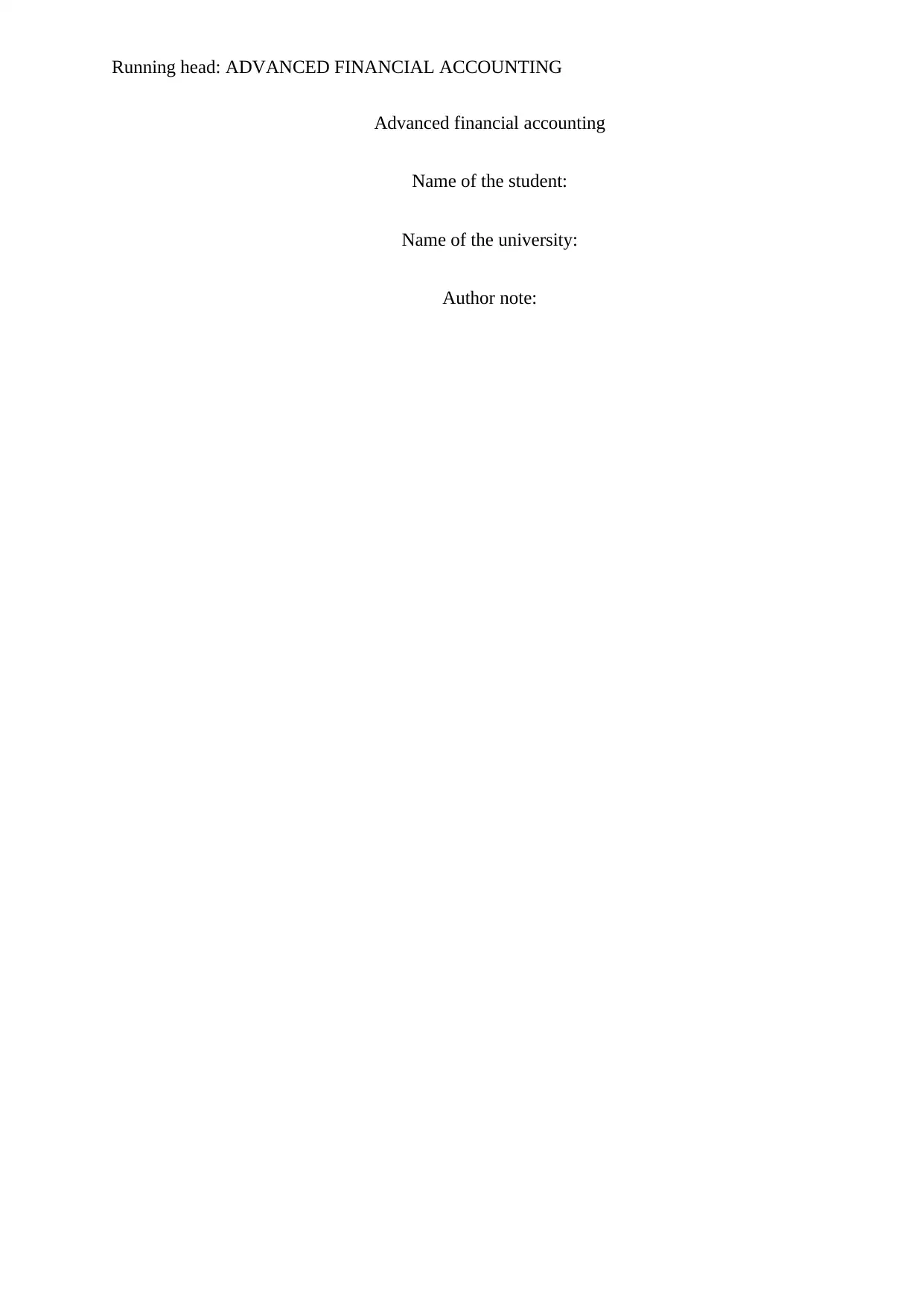
Running head: ADVANCED FINANCIAL ACCOUNTING
Advanced financial accounting
Name of the student:
Name of the university:
Author note:
Advanced financial accounting
Name of the student:
Name of the university:
Author note:
Paraphrase This Document
Need a fresh take? Get an instant paraphrase of this document with our AI Paraphraser
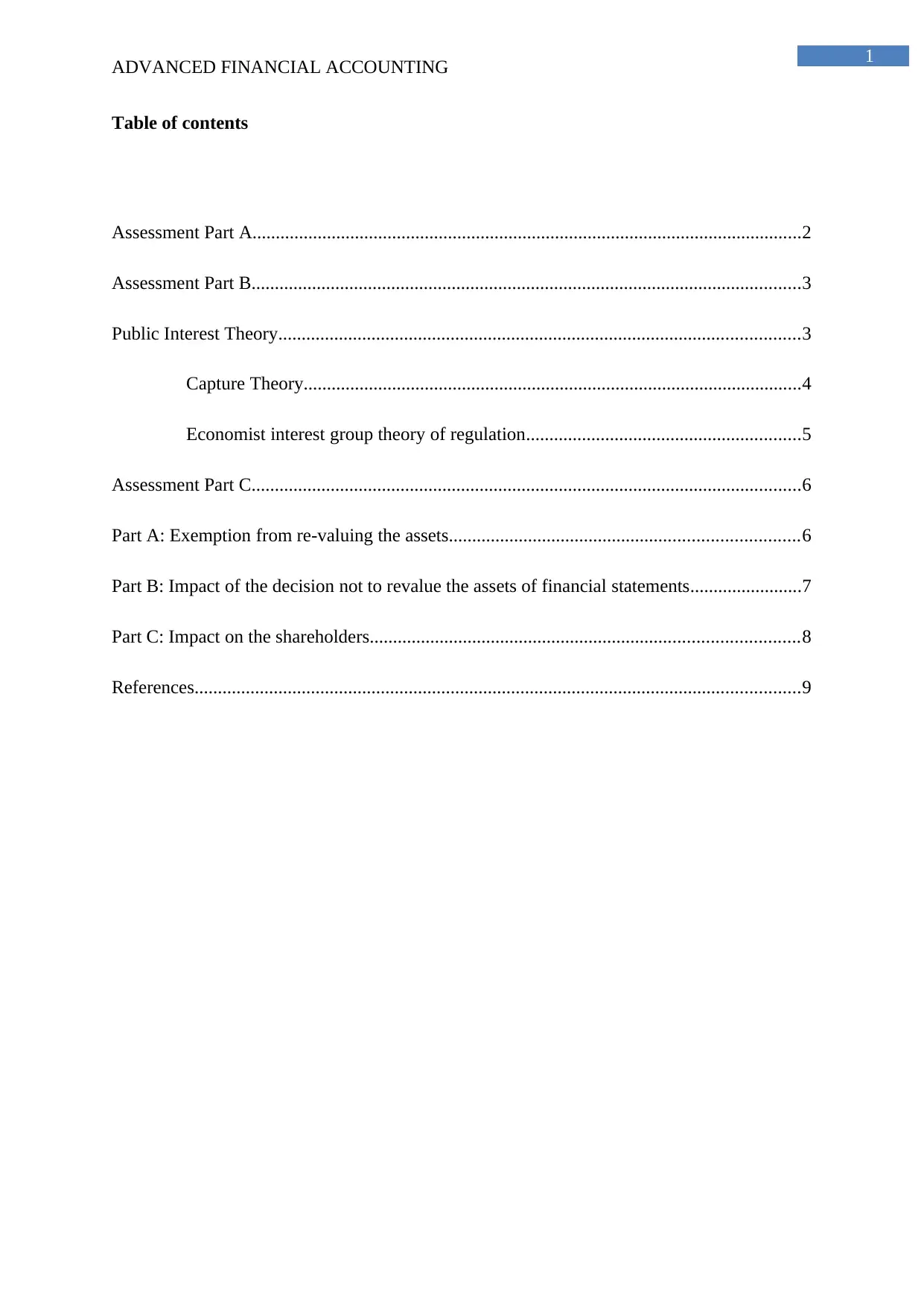
1
ADVANCED FINANCIAL ACCOUNTING
Table of contents
Assessment Part A......................................................................................................................2
Assessment Part B......................................................................................................................3
Public Interest Theory................................................................................................................3
Capture Theory...........................................................................................................4
Economist interest group theory of regulation...........................................................5
Assessment Part C......................................................................................................................6
Part A: Exemption from re-valuing the assets...........................................................................6
Part B: Impact of the decision not to revalue the assets of financial statements........................7
Part C: Impact on the shareholders............................................................................................8
References..................................................................................................................................9
ADVANCED FINANCIAL ACCOUNTING
Table of contents
Assessment Part A......................................................................................................................2
Assessment Part B......................................................................................................................3
Public Interest Theory................................................................................................................3
Capture Theory...........................................................................................................4
Economist interest group theory of regulation...........................................................5
Assessment Part C......................................................................................................................6
Part A: Exemption from re-valuing the assets...........................................................................6
Part B: Impact of the decision not to revalue the assets of financial statements........................7
Part C: Impact on the shareholders............................................................................................8
References..................................................................................................................................9
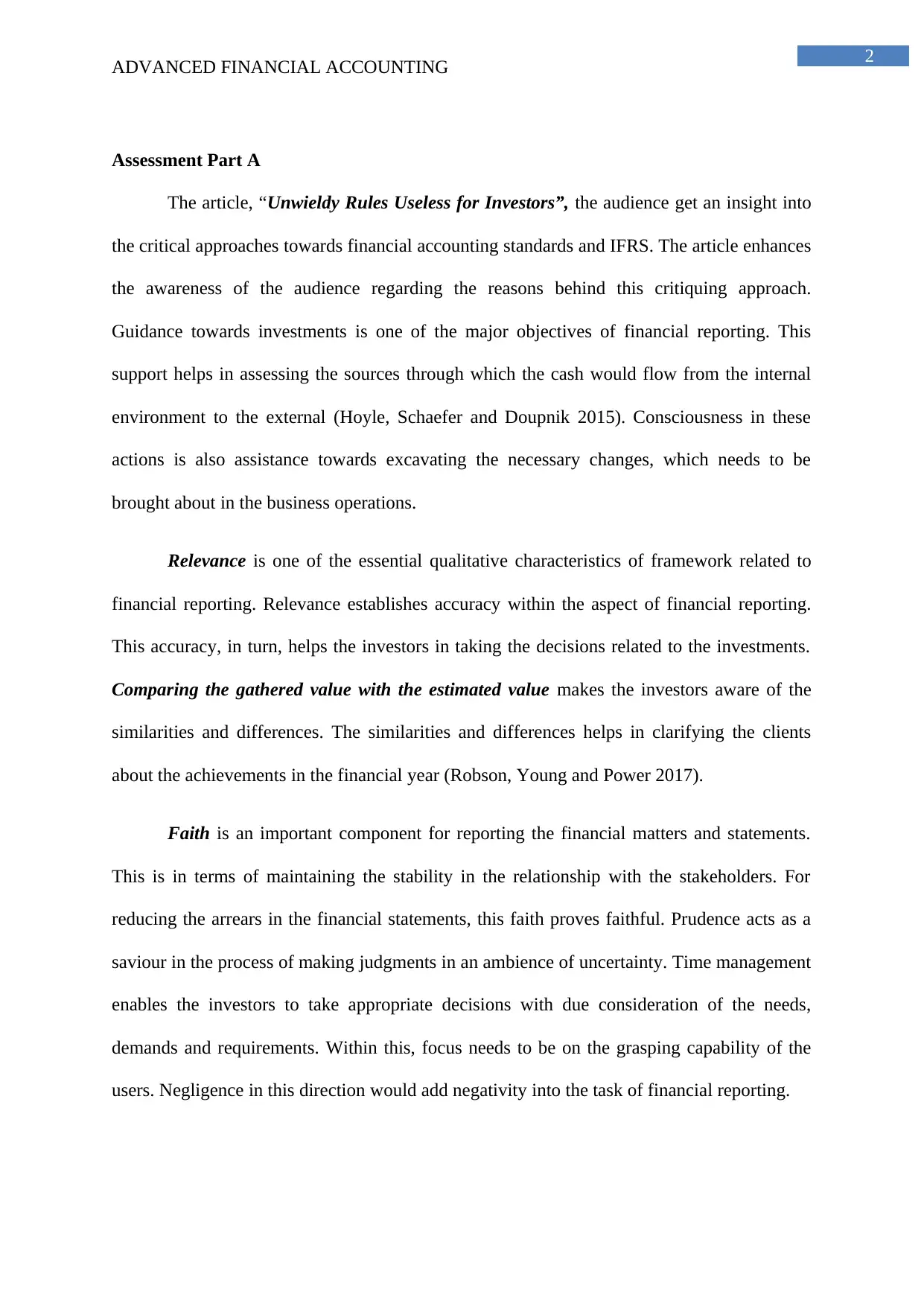
2
ADVANCED FINANCIAL ACCOUNTING
Assessment Part A
The article, “Unwieldy Rules Useless for Investors”, the audience get an insight into
the critical approaches towards financial accounting standards and IFRS. The article enhances
the awareness of the audience regarding the reasons behind this critiquing approach.
Guidance towards investments is one of the major objectives of financial reporting. This
support helps in assessing the sources through which the cash would flow from the internal
environment to the external (Hoyle, Schaefer and Doupnik 2015). Consciousness in these
actions is also assistance towards excavating the necessary changes, which needs to be
brought about in the business operations.
Relevance is one of the essential qualitative characteristics of framework related to
financial reporting. Relevance establishes accuracy within the aspect of financial reporting.
This accuracy, in turn, helps the investors in taking the decisions related to the investments.
Comparing the gathered value with the estimated value makes the investors aware of the
similarities and differences. The similarities and differences helps in clarifying the clients
about the achievements in the financial year (Robson, Young and Power 2017).
Faith is an important component for reporting the financial matters and statements.
This is in terms of maintaining the stability in the relationship with the stakeholders. For
reducing the arrears in the financial statements, this faith proves faithful. Prudence acts as a
saviour in the process of making judgments in an ambience of uncertainty. Time management
enables the investors to take appropriate decisions with due consideration of the needs,
demands and requirements. Within this, focus needs to be on the grasping capability of the
users. Negligence in this direction would add negativity into the task of financial reporting.
ADVANCED FINANCIAL ACCOUNTING
Assessment Part A
The article, “Unwieldy Rules Useless for Investors”, the audience get an insight into
the critical approaches towards financial accounting standards and IFRS. The article enhances
the awareness of the audience regarding the reasons behind this critiquing approach.
Guidance towards investments is one of the major objectives of financial reporting. This
support helps in assessing the sources through which the cash would flow from the internal
environment to the external (Hoyle, Schaefer and Doupnik 2015). Consciousness in these
actions is also assistance towards excavating the necessary changes, which needs to be
brought about in the business operations.
Relevance is one of the essential qualitative characteristics of framework related to
financial reporting. Relevance establishes accuracy within the aspect of financial reporting.
This accuracy, in turn, helps the investors in taking the decisions related to the investments.
Comparing the gathered value with the estimated value makes the investors aware of the
similarities and differences. The similarities and differences helps in clarifying the clients
about the achievements in the financial year (Robson, Young and Power 2017).
Faith is an important component for reporting the financial matters and statements.
This is in terms of maintaining the stability in the relationship with the stakeholders. For
reducing the arrears in the financial statements, this faith proves faithful. Prudence acts as a
saviour in the process of making judgments in an ambience of uncertainty. Time management
enables the investors to take appropriate decisions with due consideration of the needs,
demands and requirements. Within this, focus needs to be on the grasping capability of the
users. Negligence in this direction would add negativity into the task of financial reporting.
⊘ This is a preview!⊘
Do you want full access?
Subscribe today to unlock all pages.

Trusted by 1+ million students worldwide

3
ADVANCED FINANCIAL ACCOUNTING
Unsatisfactory results achieved by the respondents of the article add an interrogative
parameter to the practices adopted for reporting financial statements (Macve 2015). Irrelevant
IFRS adjustments create discrepancies, aggravating the complexities of the investors
regarding the reporting of financial statements. Irrelevance in the financial statements has
made the comparison process difficult for the companies and organizations. Incapability
towards making the investments has increased the instabilities in the financial parameter.
Conceptual framework helps in gaining an insight into the approaches towards
fulfilling the identified objectives related to financial reporting. Inclusion of the objectives
within the conceptual framework aids in evaluating the approach towards serving the
stakeholders (Ghanbari and Sarfia 2016). Development of this framework helps in assessing
the feasibility of the plans in terms of the specific tastes and preference of the stakeholders.
Assessment Part B
Public Interest Theory
A.C. Pigou proposed the public interest theory in the year 1932. It deals with the
sensitive nature of the markets. This sensitivity is a deviation from the usual functions, which
a market needs to perform. Here, the focus is on the needs of the buyers rather than social
welfare. Government intervention is crucial in terms of manage the market operations.
Legislations are crucial for mitigating the wrong means for carrying out the marketing tasks.
Complying with the standards and codes of these legislations assists the marketers to cater to
the public interest (Dutta and Patatoukas 2016). This aspect contradicts the true essence of
this theory. Social welfare is the main duty of the regulatory body, which includes prevention
of the malpractices, which destroys the true purpose of marketing.
ADVANCED FINANCIAL ACCOUNTING
Unsatisfactory results achieved by the respondents of the article add an interrogative
parameter to the practices adopted for reporting financial statements (Macve 2015). Irrelevant
IFRS adjustments create discrepancies, aggravating the complexities of the investors
regarding the reporting of financial statements. Irrelevance in the financial statements has
made the comparison process difficult for the companies and organizations. Incapability
towards making the investments has increased the instabilities in the financial parameter.
Conceptual framework helps in gaining an insight into the approaches towards
fulfilling the identified objectives related to financial reporting. Inclusion of the objectives
within the conceptual framework aids in evaluating the approach towards serving the
stakeholders (Ghanbari and Sarfia 2016). Development of this framework helps in assessing
the feasibility of the plans in terms of the specific tastes and preference of the stakeholders.
Assessment Part B
Public Interest Theory
A.C. Pigou proposed the public interest theory in the year 1932. It deals with the
sensitive nature of the markets. This sensitivity is a deviation from the usual functions, which
a market needs to perform. Here, the focus is on the needs of the buyers rather than social
welfare. Government intervention is crucial in terms of manage the market operations.
Legislations are crucial for mitigating the wrong means for carrying out the marketing tasks.
Complying with the standards and codes of these legislations assists the marketers to cater to
the public interest (Dutta and Patatoukas 2016). This aspect contradicts the true essence of
this theory. Social welfare is the main duty of the regulatory body, which includes prevention
of the malpractices, which destroys the true purpose of marketing.
Paraphrase This Document
Need a fresh take? Get an instant paraphrase of this document with our AI Paraphraser

4
ADVANCED FINANCIAL ACCOUNTING
Stigler proposed a theory in 1972, which catered to the search of unemployment. This
can be contrasted with the public interest theory. Employment is an issue of public interest
and unemployment opposes the aspects of regulation and equal distribution of resources, as
proposed by Stigler in his theoretical concepts. Countering this, regulations can modify the
fate of the candidates in search of enhancing their professionalism. Regulations attain a
backseat in the statements of Stigler in comparison to the effectiveness of regulation in the
fair marketing practices in the private enterprises. Along with this, regulations is considered
as an agent for dealing with the new entrants, which might add vulnerability into the market
position of the companies and organizations in a competitive ambience (Weygandt, Kimmel
and Kieso 2015). In the process of disclosing the financial information, security is maintained
in terms of not disclosing the secret and confidential statements. Consciousness in this
direction creates an impact of the society as a whole.
Taking strict steps is necessary for reducing the marketing activities, which is
affecting the public interest. For this, legislations play an important role. The private
enterprises are ought to provide the details of the activities to the statutory bodies for
restoring justice. Developing plans for gaining the lost respect is an innovative means
towards gaining the trust, loyalty and dependence from the clients. Typical example can be
online survey forms (Beams, Brozovsky and Shoulders 2017). Providing access to the people
regarding the legislations would aid in gaining an insight into their approaches towards the
undertaken steps. Taking the help of social media would help the personnel to engage with a
large mass of audience. Panel supervision would act as a further assistance towards assessing
the effectiveness, feasibility and appropriateness of the plans and programs.
Capture Theory
Capture theory deals with the actions performed by the workers for taking the
industry to the peak of success. Provision of a safe and comfortable workplace along with
ADVANCED FINANCIAL ACCOUNTING
Stigler proposed a theory in 1972, which catered to the search of unemployment. This
can be contrasted with the public interest theory. Employment is an issue of public interest
and unemployment opposes the aspects of regulation and equal distribution of resources, as
proposed by Stigler in his theoretical concepts. Countering this, regulations can modify the
fate of the candidates in search of enhancing their professionalism. Regulations attain a
backseat in the statements of Stigler in comparison to the effectiveness of regulation in the
fair marketing practices in the private enterprises. Along with this, regulations is considered
as an agent for dealing with the new entrants, which might add vulnerability into the market
position of the companies and organizations in a competitive ambience (Weygandt, Kimmel
and Kieso 2015). In the process of disclosing the financial information, security is maintained
in terms of not disclosing the secret and confidential statements. Consciousness in this
direction creates an impact of the society as a whole.
Taking strict steps is necessary for reducing the marketing activities, which is
affecting the public interest. For this, legislations play an important role. The private
enterprises are ought to provide the details of the activities to the statutory bodies for
restoring justice. Developing plans for gaining the lost respect is an innovative means
towards gaining the trust, loyalty and dependence from the clients. Typical example can be
online survey forms (Beams, Brozovsky and Shoulders 2017). Providing access to the people
regarding the legislations would aid in gaining an insight into their approaches towards the
undertaken steps. Taking the help of social media would help the personnel to engage with a
large mass of audience. Panel supervision would act as a further assistance towards assessing
the effectiveness, feasibility and appropriateness of the plans and programs.
Capture Theory
Capture theory deals with the actions performed by the workers for taking the
industry to the peak of success. Provision of a safe and comfortable workplace along with
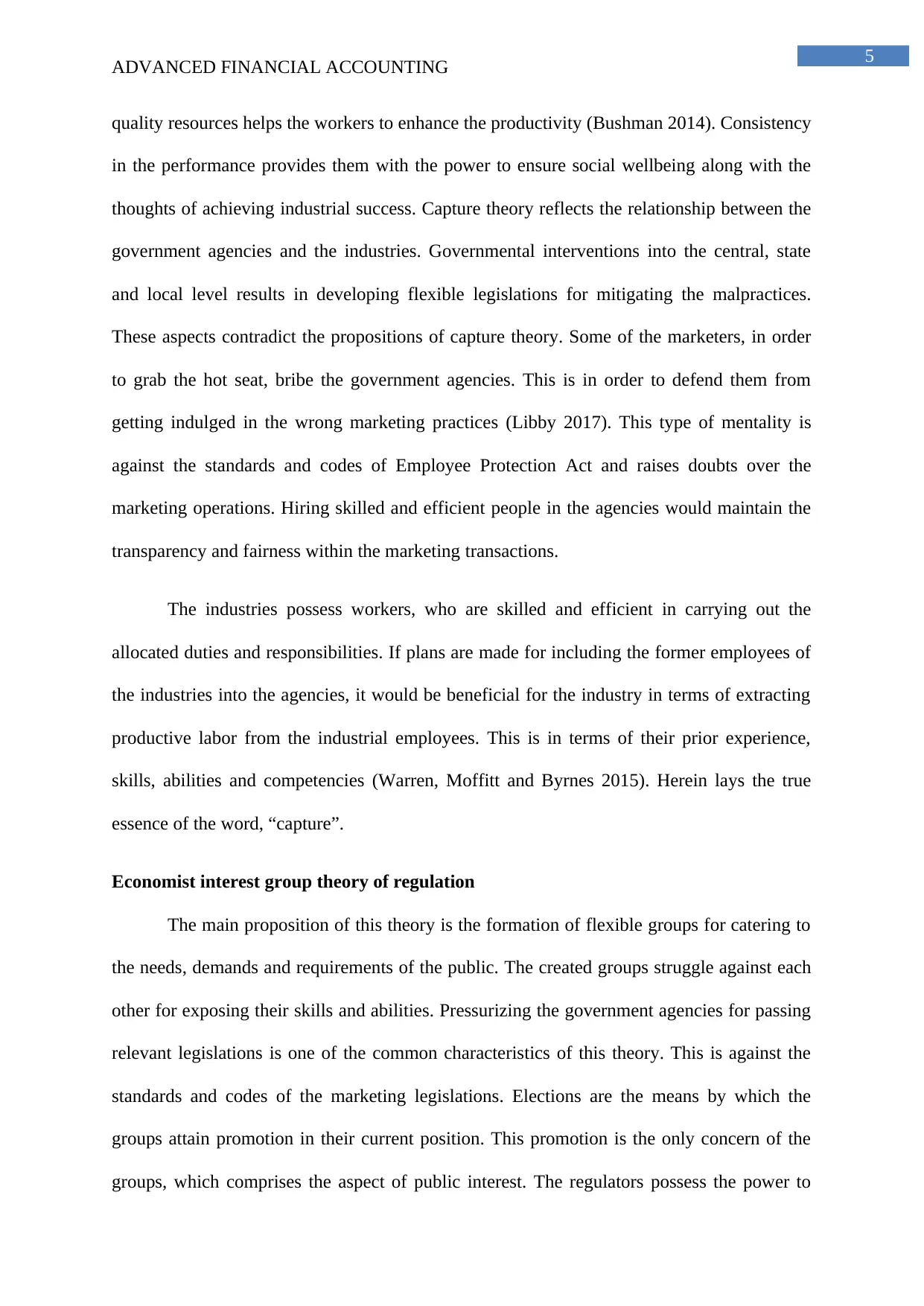
5
ADVANCED FINANCIAL ACCOUNTING
quality resources helps the workers to enhance the productivity (Bushman 2014). Consistency
in the performance provides them with the power to ensure social wellbeing along with the
thoughts of achieving industrial success. Capture theory reflects the relationship between the
government agencies and the industries. Governmental interventions into the central, state
and local level results in developing flexible legislations for mitigating the malpractices.
These aspects contradict the propositions of capture theory. Some of the marketers, in order
to grab the hot seat, bribe the government agencies. This is in order to defend them from
getting indulged in the wrong marketing practices (Libby 2017). This type of mentality is
against the standards and codes of Employee Protection Act and raises doubts over the
marketing operations. Hiring skilled and efficient people in the agencies would maintain the
transparency and fairness within the marketing transactions.
The industries possess workers, who are skilled and efficient in carrying out the
allocated duties and responsibilities. If plans are made for including the former employees of
the industries into the agencies, it would be beneficial for the industry in terms of extracting
productive labor from the industrial employees. This is in terms of their prior experience,
skills, abilities and competencies (Warren, Moffitt and Byrnes 2015). Herein lays the true
essence of the word, “capture”.
Economist interest group theory of regulation
The main proposition of this theory is the formation of flexible groups for catering to
the needs, demands and requirements of the public. The created groups struggle against each
other for exposing their skills and abilities. Pressurizing the government agencies for passing
relevant legislations is one of the common characteristics of this theory. This is against the
standards and codes of the marketing legislations. Elections are the means by which the
groups attain promotion in their current position. This promotion is the only concern of the
groups, which comprises the aspect of public interest. The regulators possess the power to
ADVANCED FINANCIAL ACCOUNTING
quality resources helps the workers to enhance the productivity (Bushman 2014). Consistency
in the performance provides them with the power to ensure social wellbeing along with the
thoughts of achieving industrial success. Capture theory reflects the relationship between the
government agencies and the industries. Governmental interventions into the central, state
and local level results in developing flexible legislations for mitigating the malpractices.
These aspects contradict the propositions of capture theory. Some of the marketers, in order
to grab the hot seat, bribe the government agencies. This is in order to defend them from
getting indulged in the wrong marketing practices (Libby 2017). This type of mentality is
against the standards and codes of Employee Protection Act and raises doubts over the
marketing operations. Hiring skilled and efficient people in the agencies would maintain the
transparency and fairness within the marketing transactions.
The industries possess workers, who are skilled and efficient in carrying out the
allocated duties and responsibilities. If plans are made for including the former employees of
the industries into the agencies, it would be beneficial for the industry in terms of extracting
productive labor from the industrial employees. This is in terms of their prior experience,
skills, abilities and competencies (Warren, Moffitt and Byrnes 2015). Herein lays the true
essence of the word, “capture”.
Economist interest group theory of regulation
The main proposition of this theory is the formation of flexible groups for catering to
the needs, demands and requirements of the public. The created groups struggle against each
other for exposing their skills and abilities. Pressurizing the government agencies for passing
relevant legislations is one of the common characteristics of this theory. This is against the
standards and codes of the marketing legislations. Elections are the means by which the
groups attain promotion in their current position. This promotion is the only concern of the
groups, which comprises the aspect of public interest. The regulators possess the power to
⊘ This is a preview!⊘
Do you want full access?
Subscribe today to unlock all pages.

Trusted by 1+ million students worldwide
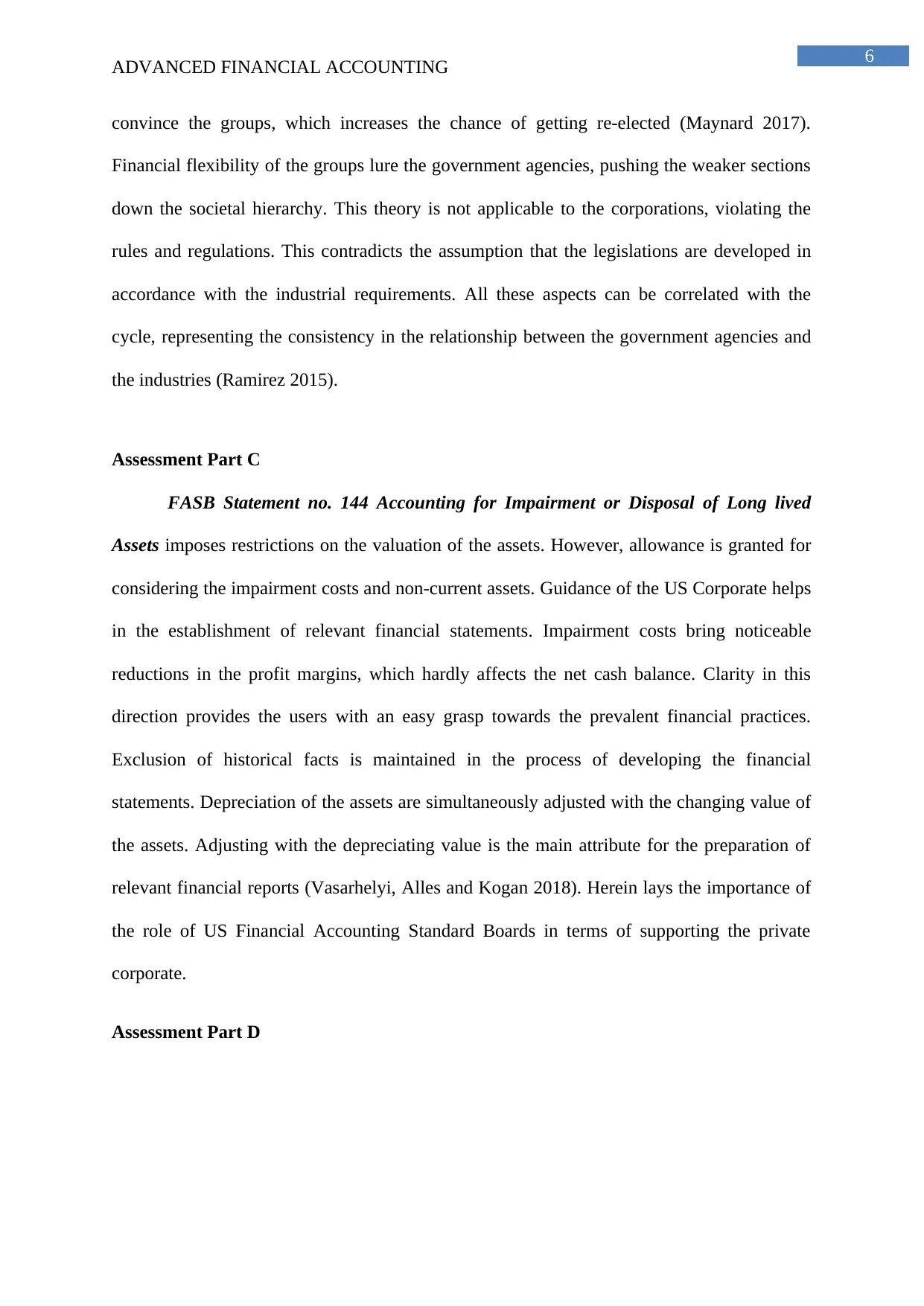
6
ADVANCED FINANCIAL ACCOUNTING
convince the groups, which increases the chance of getting re-elected (Maynard 2017).
Financial flexibility of the groups lure the government agencies, pushing the weaker sections
down the societal hierarchy. This theory is not applicable to the corporations, violating the
rules and regulations. This contradicts the assumption that the legislations are developed in
accordance with the industrial requirements. All these aspects can be correlated with the
cycle, representing the consistency in the relationship between the government agencies and
the industries (Ramirez 2015).
Assessment Part C
FASB Statement no. 144 Accounting for Impairment or Disposal of Long lived
Assets imposes restrictions on the valuation of the assets. However, allowance is granted for
considering the impairment costs and non-current assets. Guidance of the US Corporate helps
in the establishment of relevant financial statements. Impairment costs bring noticeable
reductions in the profit margins, which hardly affects the net cash balance. Clarity in this
direction provides the users with an easy grasp towards the prevalent financial practices.
Exclusion of historical facts is maintained in the process of developing the financial
statements. Depreciation of the assets are simultaneously adjusted with the changing value of
the assets. Adjusting with the depreciating value is the main attribute for the preparation of
relevant financial reports (Vasarhelyi, Alles and Kogan 2018). Herein lays the importance of
the role of US Financial Accounting Standard Boards in terms of supporting the private
corporate.
Assessment Part D
ADVANCED FINANCIAL ACCOUNTING
convince the groups, which increases the chance of getting re-elected (Maynard 2017).
Financial flexibility of the groups lure the government agencies, pushing the weaker sections
down the societal hierarchy. This theory is not applicable to the corporations, violating the
rules and regulations. This contradicts the assumption that the legislations are developed in
accordance with the industrial requirements. All these aspects can be correlated with the
cycle, representing the consistency in the relationship between the government agencies and
the industries (Ramirez 2015).
Assessment Part C
FASB Statement no. 144 Accounting for Impairment or Disposal of Long lived
Assets imposes restrictions on the valuation of the assets. However, allowance is granted for
considering the impairment costs and non-current assets. Guidance of the US Corporate helps
in the establishment of relevant financial statements. Impairment costs bring noticeable
reductions in the profit margins, which hardly affects the net cash balance. Clarity in this
direction provides the users with an easy grasp towards the prevalent financial practices.
Exclusion of historical facts is maintained in the process of developing the financial
statements. Depreciation of the assets are simultaneously adjusted with the changing value of
the assets. Adjusting with the depreciating value is the main attribute for the preparation of
relevant financial reports (Vasarhelyi, Alles and Kogan 2018). Herein lays the importance of
the role of US Financial Accounting Standard Boards in terms of supporting the private
corporate.
Assessment Part D
Paraphrase This Document
Need a fresh take? Get an instant paraphrase of this document with our AI Paraphraser
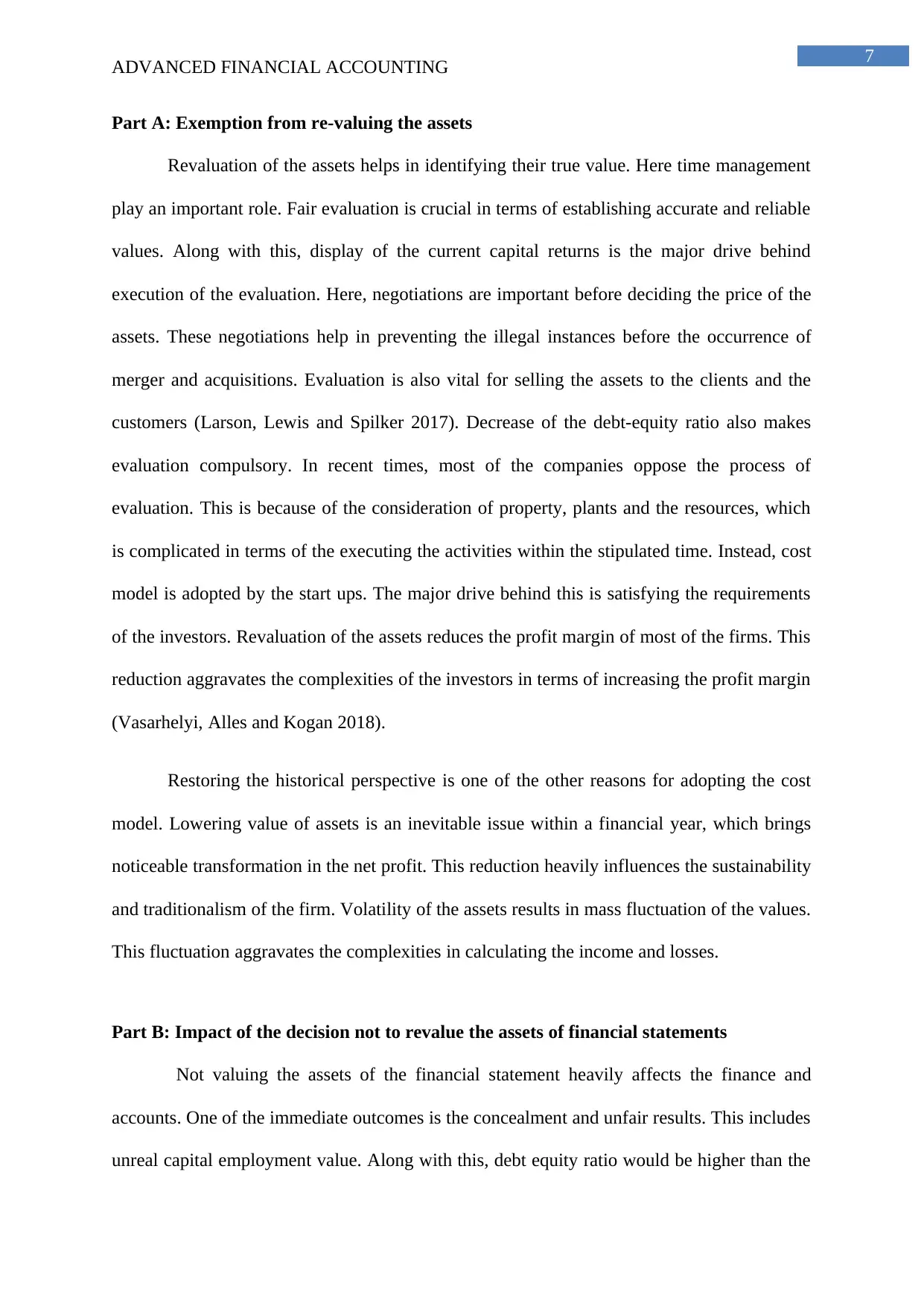
7
ADVANCED FINANCIAL ACCOUNTING
Part A: Exemption from re-valuing the assets
Revaluation of the assets helps in identifying their true value. Here time management
play an important role. Fair evaluation is crucial in terms of establishing accurate and reliable
values. Along with this, display of the current capital returns is the major drive behind
execution of the evaluation. Here, negotiations are important before deciding the price of the
assets. These negotiations help in preventing the illegal instances before the occurrence of
merger and acquisitions. Evaluation is also vital for selling the assets to the clients and the
customers (Larson, Lewis and Spilker 2017). Decrease of the debt-equity ratio also makes
evaluation compulsory. In recent times, most of the companies oppose the process of
evaluation. This is because of the consideration of property, plants and the resources, which
is complicated in terms of the executing the activities within the stipulated time. Instead, cost
model is adopted by the start ups. The major drive behind this is satisfying the requirements
of the investors. Revaluation of the assets reduces the profit margin of most of the firms. This
reduction aggravates the complexities of the investors in terms of increasing the profit margin
(Vasarhelyi, Alles and Kogan 2018).
Restoring the historical perspective is one of the other reasons for adopting the cost
model. Lowering value of assets is an inevitable issue within a financial year, which brings
noticeable transformation in the net profit. This reduction heavily influences the sustainability
and traditionalism of the firm. Volatility of the assets results in mass fluctuation of the values.
This fluctuation aggravates the complexities in calculating the income and losses.
Part B: Impact of the decision not to revalue the assets of financial statements
Not valuing the assets of the financial statement heavily affects the finance and
accounts. One of the immediate outcomes is the concealment and unfair results. This includes
unreal capital employment value. Along with this, debt equity ratio would be higher than the
ADVANCED FINANCIAL ACCOUNTING
Part A: Exemption from re-valuing the assets
Revaluation of the assets helps in identifying their true value. Here time management
play an important role. Fair evaluation is crucial in terms of establishing accurate and reliable
values. Along with this, display of the current capital returns is the major drive behind
execution of the evaluation. Here, negotiations are important before deciding the price of the
assets. These negotiations help in preventing the illegal instances before the occurrence of
merger and acquisitions. Evaluation is also vital for selling the assets to the clients and the
customers (Larson, Lewis and Spilker 2017). Decrease of the debt-equity ratio also makes
evaluation compulsory. In recent times, most of the companies oppose the process of
evaluation. This is because of the consideration of property, plants and the resources, which
is complicated in terms of the executing the activities within the stipulated time. Instead, cost
model is adopted by the start ups. The major drive behind this is satisfying the requirements
of the investors. Revaluation of the assets reduces the profit margin of most of the firms. This
reduction aggravates the complexities of the investors in terms of increasing the profit margin
(Vasarhelyi, Alles and Kogan 2018).
Restoring the historical perspective is one of the other reasons for adopting the cost
model. Lowering value of assets is an inevitable issue within a financial year, which brings
noticeable transformation in the net profit. This reduction heavily influences the sustainability
and traditionalism of the firm. Volatility of the assets results in mass fluctuation of the values.
This fluctuation aggravates the complexities in calculating the income and losses.
Part B: Impact of the decision not to revalue the assets of financial statements
Not valuing the assets of the financial statement heavily affects the finance and
accounts. One of the immediate outcomes is the concealment and unfair results. This includes
unreal capital employment value. Along with this, debt equity ratio would be higher than the
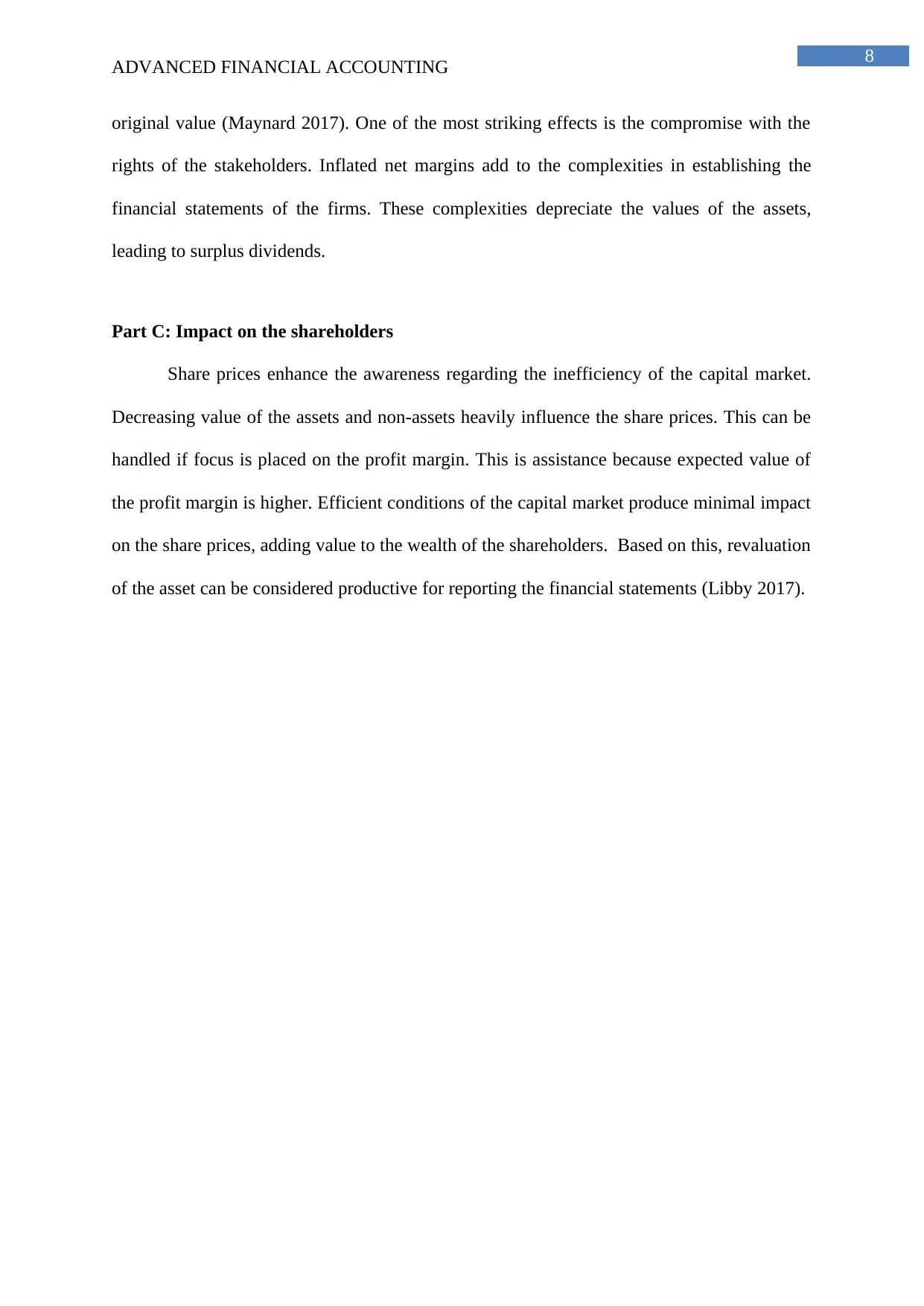
8
ADVANCED FINANCIAL ACCOUNTING
original value (Maynard 2017). One of the most striking effects is the compromise with the
rights of the stakeholders. Inflated net margins add to the complexities in establishing the
financial statements of the firms. These complexities depreciate the values of the assets,
leading to surplus dividends.
Part C: Impact on the shareholders
Share prices enhance the awareness regarding the inefficiency of the capital market.
Decreasing value of the assets and non-assets heavily influence the share prices. This can be
handled if focus is placed on the profit margin. This is assistance because expected value of
the profit margin is higher. Efficient conditions of the capital market produce minimal impact
on the share prices, adding value to the wealth of the shareholders. Based on this, revaluation
of the asset can be considered productive for reporting the financial statements (Libby 2017).
ADVANCED FINANCIAL ACCOUNTING
original value (Maynard 2017). One of the most striking effects is the compromise with the
rights of the stakeholders. Inflated net margins add to the complexities in establishing the
financial statements of the firms. These complexities depreciate the values of the assets,
leading to surplus dividends.
Part C: Impact on the shareholders
Share prices enhance the awareness regarding the inefficiency of the capital market.
Decreasing value of the assets and non-assets heavily influence the share prices. This can be
handled if focus is placed on the profit margin. This is assistance because expected value of
the profit margin is higher. Efficient conditions of the capital market produce minimal impact
on the share prices, adding value to the wealth of the shareholders. Based on this, revaluation
of the asset can be considered productive for reporting the financial statements (Libby 2017).
⊘ This is a preview!⊘
Do you want full access?
Subscribe today to unlock all pages.

Trusted by 1+ million students worldwide
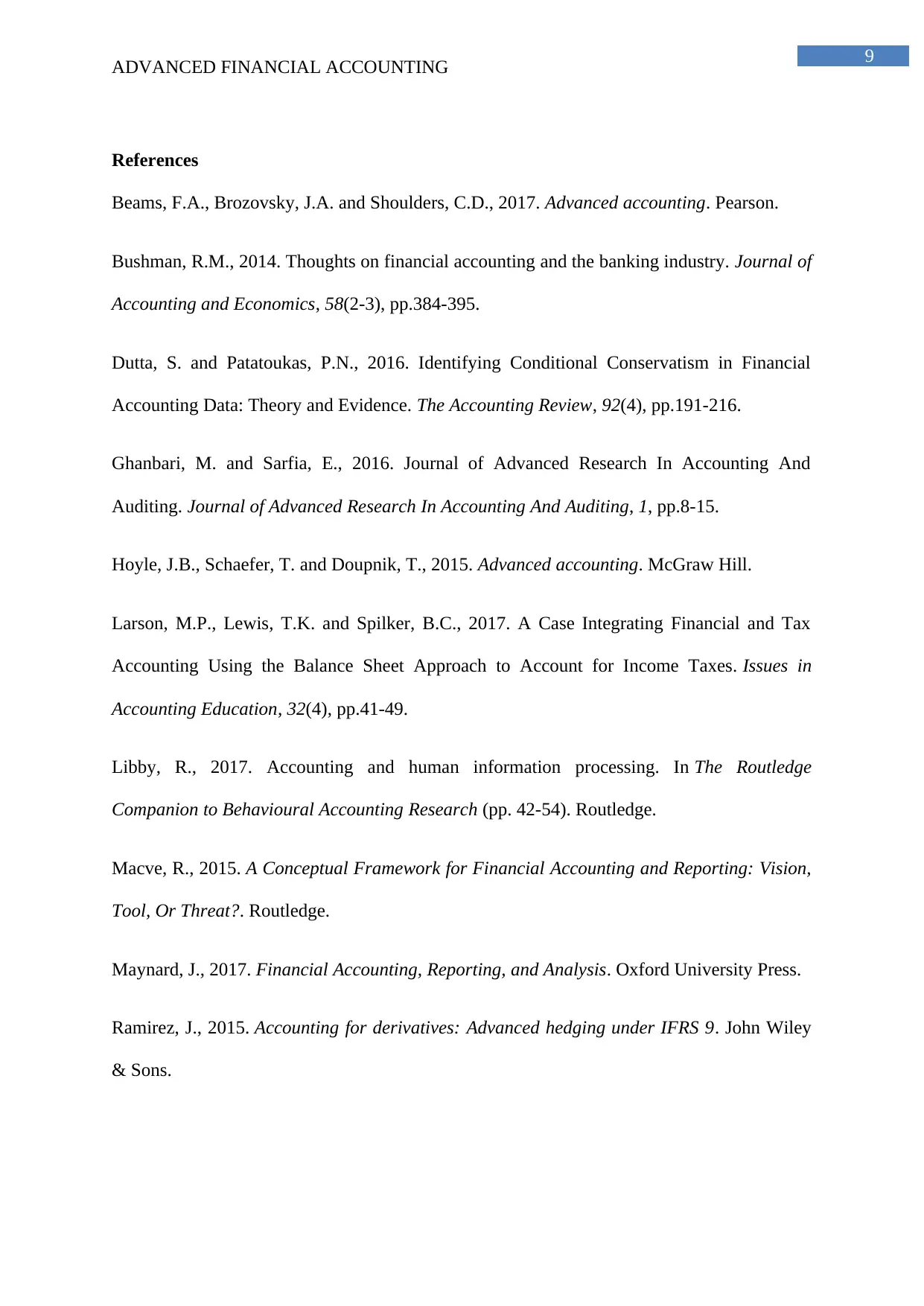
9
ADVANCED FINANCIAL ACCOUNTING
References
Beams, F.A., Brozovsky, J.A. and Shoulders, C.D., 2017. Advanced accounting. Pearson.
Bushman, R.M., 2014. Thoughts on financial accounting and the banking industry. Journal of
Accounting and Economics, 58(2-3), pp.384-395.
Dutta, S. and Patatoukas, P.N., 2016. Identifying Conditional Conservatism in Financial
Accounting Data: Theory and Evidence. The Accounting Review, 92(4), pp.191-216.
Ghanbari, M. and Sarfia, E., 2016. Journal of Advanced Research In Accounting And
Auditing. Journal of Advanced Research In Accounting And Auditing, 1, pp.8-15.
Hoyle, J.B., Schaefer, T. and Doupnik, T., 2015. Advanced accounting. McGraw Hill.
Larson, M.P., Lewis, T.K. and Spilker, B.C., 2017. A Case Integrating Financial and Tax
Accounting Using the Balance Sheet Approach to Account for Income Taxes. Issues in
Accounting Education, 32(4), pp.41-49.
Libby, R., 2017. Accounting and human information processing. In The Routledge
Companion to Behavioural Accounting Research (pp. 42-54). Routledge.
Macve, R., 2015. A Conceptual Framework for Financial Accounting and Reporting: Vision,
Tool, Or Threat?. Routledge.
Maynard, J., 2017. Financial Accounting, Reporting, and Analysis. Oxford University Press.
Ramirez, J., 2015. Accounting for derivatives: Advanced hedging under IFRS 9. John Wiley
& Sons.
ADVANCED FINANCIAL ACCOUNTING
References
Beams, F.A., Brozovsky, J.A. and Shoulders, C.D., 2017. Advanced accounting. Pearson.
Bushman, R.M., 2014. Thoughts on financial accounting and the banking industry. Journal of
Accounting and Economics, 58(2-3), pp.384-395.
Dutta, S. and Patatoukas, P.N., 2016. Identifying Conditional Conservatism in Financial
Accounting Data: Theory and Evidence. The Accounting Review, 92(4), pp.191-216.
Ghanbari, M. and Sarfia, E., 2016. Journal of Advanced Research In Accounting And
Auditing. Journal of Advanced Research In Accounting And Auditing, 1, pp.8-15.
Hoyle, J.B., Schaefer, T. and Doupnik, T., 2015. Advanced accounting. McGraw Hill.
Larson, M.P., Lewis, T.K. and Spilker, B.C., 2017. A Case Integrating Financial and Tax
Accounting Using the Balance Sheet Approach to Account for Income Taxes. Issues in
Accounting Education, 32(4), pp.41-49.
Libby, R., 2017. Accounting and human information processing. In The Routledge
Companion to Behavioural Accounting Research (pp. 42-54). Routledge.
Macve, R., 2015. A Conceptual Framework for Financial Accounting and Reporting: Vision,
Tool, Or Threat?. Routledge.
Maynard, J., 2017. Financial Accounting, Reporting, and Analysis. Oxford University Press.
Ramirez, J., 2015. Accounting for derivatives: Advanced hedging under IFRS 9. John Wiley
& Sons.
Paraphrase This Document
Need a fresh take? Get an instant paraphrase of this document with our AI Paraphraser
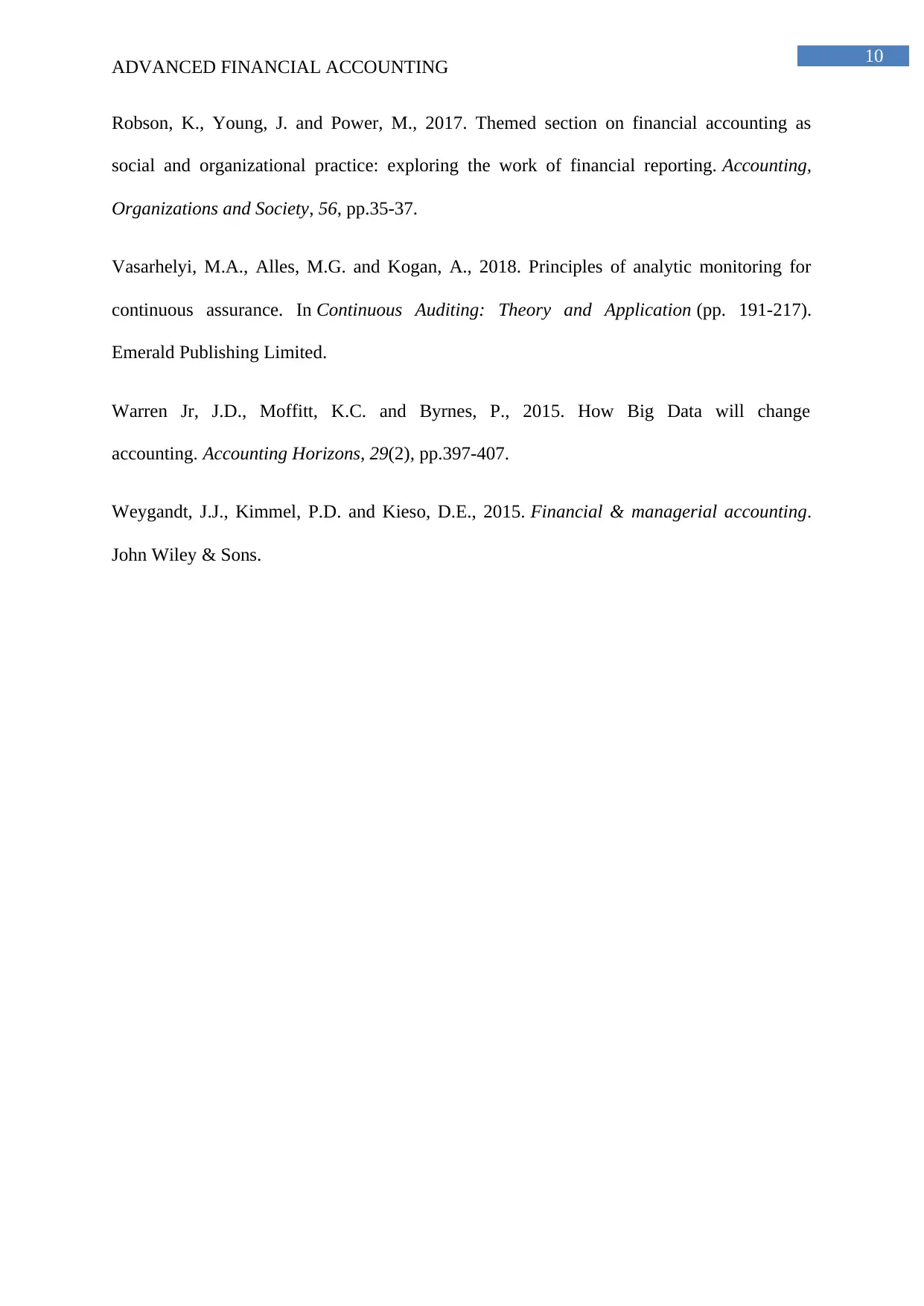
10
ADVANCED FINANCIAL ACCOUNTING
Robson, K., Young, J. and Power, M., 2017. Themed section on financial accounting as
social and organizational practice: exploring the work of financial reporting. Accounting,
Organizations and Society, 56, pp.35-37.
Vasarhelyi, M.A., Alles, M.G. and Kogan, A., 2018. Principles of analytic monitoring for
continuous assurance. In Continuous Auditing: Theory and Application (pp. 191-217).
Emerald Publishing Limited.
Warren Jr, J.D., Moffitt, K.C. and Byrnes, P., 2015. How Big Data will change
accounting. Accounting Horizons, 29(2), pp.397-407.
Weygandt, J.J., Kimmel, P.D. and Kieso, D.E., 2015. Financial & managerial accounting.
John Wiley & Sons.
ADVANCED FINANCIAL ACCOUNTING
Robson, K., Young, J. and Power, M., 2017. Themed section on financial accounting as
social and organizational practice: exploring the work of financial reporting. Accounting,
Organizations and Society, 56, pp.35-37.
Vasarhelyi, M.A., Alles, M.G. and Kogan, A., 2018. Principles of analytic monitoring for
continuous assurance. In Continuous Auditing: Theory and Application (pp. 191-217).
Emerald Publishing Limited.
Warren Jr, J.D., Moffitt, K.C. and Byrnes, P., 2015. How Big Data will change
accounting. Accounting Horizons, 29(2), pp.397-407.
Weygandt, J.J., Kimmel, P.D. and Kieso, D.E., 2015. Financial & managerial accounting.
John Wiley & Sons.
1 out of 11
Related Documents
Your All-in-One AI-Powered Toolkit for Academic Success.
+13062052269
info@desklib.com
Available 24*7 on WhatsApp / Email
![[object Object]](/_next/static/media/star-bottom.7253800d.svg)
Unlock your academic potential
Copyright © 2020–2025 A2Z Services. All Rights Reserved. Developed and managed by ZUCOL.





